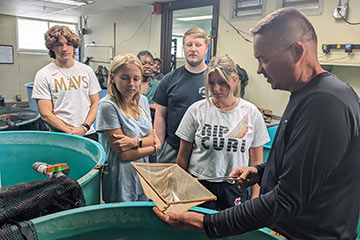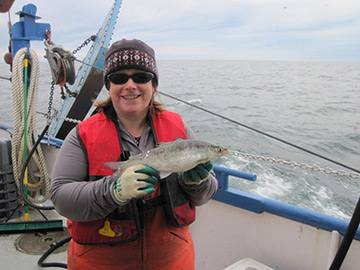
06/23/2023
SUNY Cortland and SUNY Oswego faculty and students are collaborating with the federal Tunison Lake Ontario Biological Station in Cortland and many other agencies and organizations to save a critical piece of the Great Lakes ecosystem.
This research project is made possible by a $634,546 United States Geological Services (USGS) grant, which is eligible to be extended through five years, for a potential total of more than $3 million.
The initiative is part of the USGS’ Coregonine Restoration Framework, a plan endorsed in 2018 by fishery managers representing eight U.S. states, three U.S. intertribal organizations and the Canadian province of Ontario. It seeks to restore and conserve the coregonine subfamily of freshwater fish — including freshwater whitefish — found in the Great Lakes.
“I'm really excited about this new partnership between the SUNY institutions and the USGS Tunison Lab.” said Li Jin, professor in SUNY Cortland’s Geology Department, and coordinator of its environmental sciences program. “Also, when we were seeking the funding opportunities, there were remarkable collaborative efforts between SUNY Oswego and Cortland, rather than competing with one another. It is exciting to see this project help set a new stage for engaging interactions among students and faculty from both Universities.”

The coregonine were once harvested at commercial fisheries and still serve as part of the food chain for other commercial fish, making them vital for both a healthy ecosystem and economy. Great Lakes fisheries are worth $7 billion and support over 75,000 jobs annually, according to project leader and SUNY Oswego biological sciences faculty member Nicholas Sard.
“Impediments like habitat destruction, overfishing and interactions with invasive species have drastically reduced population sizes and, in some cases, resulted in the extinction of native fish species,” Sard said. “This project seeks to restore native fish populations … by studying remediation actions to overcome these impediments.”
The work of the SUNY researchers will help reveal the best ways to transport, raise and reintroduce the fish — techniques that still have little hard data in the Great Lakes Basin. Pollution, overfishing and climate change have all contributed to their decline, but the exact impact of each is still unknown.
Jin and Andrea Dávalos, associate professor in SUNY Cortland’s Biological Sciences Department, are running the Cortland end of the project, while Mary Beth Voltura, associate professor in Biological Sciences, is coordinating the student interns’ participation.
“We wanted to develop a program that was focused on research and internship opportunities for students, especially for identities that are usually minoritized in the sciences,” Dávalos said.
Five interns were selected from a group of applicants to join the project this first year: Preston Fuerbacher, Morgan Bulger and Kayelah Brown from SUNY Cortland and Collin Atwood and Joe Sweeney from SUNY Oswego. They’ll gain experience running a hatchery and performing field and lab work. The students will be expected to produce a presentation given at a symposium hosted by SUNY Cortland this fall.
"I’m most excited about learning about the various fish species located in the lakes near the Cortland campus,” said Brown, a biological sciences major. “I’m also super excited to make more connections with the new people that I meet.”
Professor Patricia Conklin, chair of SUNY Cortland’s Biological Sciences, led the effort to apply for inclusion of SUNY Cortland as a University Partner in the federal Cooperative Ecosystem Studies Units (CESU). Joining the Great Lakes — Northern Forests CESU then opened the opportunity to apply for the grant funding the project. Late last year, SUNY Cortland was invited to Tunison, where a possible collaboration and the chance to have students involved in the process were discussed.
SUNY Oswego will lead the main research activities, while Cortland focuses on the educational experience of the interns from both universities.
Tunison is being upgraded by the USGS Great Lakes Science Center to better fit the experimental needs required to conserve and restore the coregonine. As part of the update, it’s being administratively joined with the Lake Ontario Biological Station in Oswego. The new experimental and fish-rearing potential of Tunison should align well with the in-lake experimental capabilities of the Oswego lab.
“This new program involving the USGS Great Lakes Science Center, SUNY Oswego and SUNY Cortland is invaluable at several levels,” said Conklin. “For our Cortland students, it provides hands-on research experience in conservation and the chance to network with federal scientists as well as students and faculty at SUNY Owego. It will also contribute extra hands and dollars toward the restoration of coregonines, helping restore this keystone subfamily of fishes in the Great Lakes.”
Another goal of the project is to increase the representation of women and racial and ethnic minorities in STEM and at fisheries. Fostering a diverse workforce is expected to help develop the next generation of fishery scientists.
“One of the priorities of SUNY Cortland is to provide our students with a transformational education through experiences that go beyond the classroom, including partnerships with organizations in our region,” said Voltura. “The USGS Tunison Laboratory of Aquatic Science, with its close proximity to SUNY Cortland and active research programs, provides an excellent opportunity for our students to extend their learning through interactions with scientists working in natural resource management at the national level.”
———
From left: SUNY Oswego student Collin Atwood; SUNY Cortland students Preston Fuerbacher and Kayla Brown; Richard Chiavelli, a USGS fish culturist; SUNY Oswego student Joseph Sweeney; SUNY Cortland student Morgan Bulger; and Gregg Mackey, a USGS fish culturist, at the Tunison Lake Ontario Biological Station in Cortland.